History of art criticism: Aby Warburg and the origins of iconology
Thegreater the strength of the artist, the more accomplished form the predicate has, the weaker that predicate is, the more undeveloped the subject expressed in a periphrasis. So wrote the German art historian Aby Warburg (Hamburg, 1866 - 1929, real name Abraham Moritz Warburg) in 1890, when he was only twenty-four years old, highlighting the limitations of formalist criticism. Warburg was convinced that reducing the analysis of a work of art to a mere formal question was an approach not only limiting but also to be avoided and even despised. Warburg, in fact, believed that images were icons charged with meanings having a close relationship to the culture and memory of a society. Images, in other words, have a history, because an image survives the ages and perpetuates itself through time by following different styles: not by chance, Warburg spoke precisely of Nachleben, or “survival.” There are, for example, repertories that have been passed down from classical antiquity to the Renaissance (we use the example of the Renaissance because Warburg graduated with a dissertation on Sandro Botticelli and always had a certain interest in the Renaissance), and in turn such repertories arise “as a vehicle of collective representations,” to use an effective expression of the anthropologist Carlo Severi, author of interesting essays on images according to Warburg. Consequently, since images are closely connected to the memory of a society, Warburg “reduces himself neither to the reading of a style nor to the pure iconological deciphering of images”: Warburg, in an entirely original way, tries to identify the whole complex history behind an image, in order to better contextualize it, to explain the reasons behind it, to fully understand the choices of an artist, to understand how the figure of the artist is placed within the collective memory of a society.
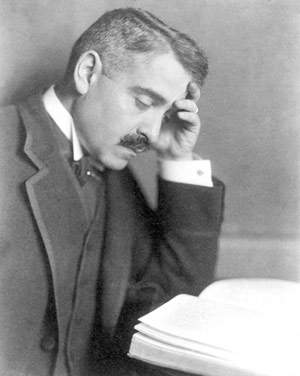 |
| Aby Warburg |
One of the most effective proofs in this regard is his interpretation, contained in a 1912 essay, of Francesco del Cossa ’sAllegory of the Month of March, which we see in the frescoes of Palazzo Schifanoia in Ferrara. In the central part of this depiction, a female figure placed above the ram symbolizing the zodiac sign of the month is placed between two additional figures: a black man, dressed in rags and holding a rope, and an elegantly dressed white man holding an arrow and a ring in his hands. Warburg was able to trace the cycle’s sources precisely from the figure of the man with the rope, the vir niger who, in a sense, “opens” the Ferrara frescoes. In fact, while the scholar was trying to make sense of the figures, he had begun reading the German translation of an Arabic treatise written in the year 850: theIntroductorium in astronomiam by the astronomer and astrologer Albumasar, whose writings we know circulated in Europe, translated into Latin, as early as the Middle Ages. In his book, Albumasar had described the figures of the so-called"decans," ancient deities of probable Egyptian origin, later handed down to various other cultures in various forms, who presided over the thirty-six decades into which a year is divided. The three mysterious figures in the allegory of March are thus the three decans of the month. Also appearing in the book was a description of the vir niger, corresponding to the first decan of the Indian tradition, and delineated more or less in the terms in which he appears to us in Francesco del Cossa’s fresco. Warburg had thus succeeded not only in identifying the sources that had inspired the artist (i.e., an Arabic treatise, which in turn was derived from Indian writings), but had also traced the history of the iconography present on the walls of the Ferrara palace.
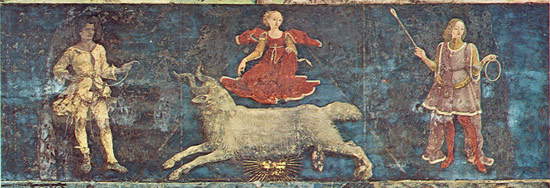 |
| Francesco Del Cossa, The Three Deans of the Month of March (c. 1468-1470; fresco; Ferrara, Palazzo Schifanoia, Salone dei Mesi) |
Warburg, who had also conducted psychoanalytic studies, in a sense applied to art history a theory that was peculiar to neurology and that, more specifically, had been elaborated by a biologist contemporary of his, Richard Semon (Berlin 1859 - Munich, 1918): Warburg had read several times and deeply appreciated his seminal work Die M neme (“The Mneme,” a term introduced by Semon himself to refer to “organic memory,” a kind of unconscious memory formed, as we shall see in a moment, by events acting on matter). In his biography on Warburg, the great art historian Ernst Gombrich explains very well his colleague’s debt to Semon: indeed, the latter believed that memory was the “capacity to react to an event over a certain period of time, that is, a form of storage and transmission of energy unknown to the physical world,” and that “every event affecting living matter leaves a trace” called an “engram.” The energy stored in these traces, in “engrams,” is reactivated when the organism that stored it remembers a given event and acts accordingly. Warburg applied this theory of memory to images: Semon’s engram becomes, for Warburg, the symbol, the image itself, and the image is derived from experiences that a society has experienced in the course of its existence. To denote this activity of a society’s memory that channels its experiences (which in turn spring from emotions) into repertoires of images, Warburg coined the term Pathosformel (literally “form of emotion”). Here, then, is one of the reasons why Warburg had a substantial disdain for formalism: because in his view, form and content are linked by an indissoluble relationship, which is, moreover, capable of transcending epochs.
In 1923, in a passage quoted in the above-mentioned biography written by Gombrich, Warburg thus expressed himself with regard to that history of art which was interested only in formal matters: a real distaste for the aestheticizing history of art had taken over for me. The formal consideration of the image, unable to understand its biological necessity as an intermediate product between religion and art seemed to me to lead only to sterile chatter. To fully understand this statement of his, it needs to be contextualized. In 1895 Warburg had recently finished his doctorate and, taking advantage of his brother Paul’s marriage to the daughter of a wealthy New York banker, moved to the United States, where he worked for some time with the Smithsonian Institute. While attending the prestigious American institute, Warburg came into contact with a number of anthropologists, such as James Mooney and Frank Hamilton Cushing, and he developed the conviction that images must have some sort of anthropological source that was common to all latitudes and eras: in other words, that the continual revival of forms, such as those fromclassical art to the Renaissance, had a common foundation, probably inherent in the human mind. Before he went to America, Warburg had dealt precisely with the Florentine Renaissance, and had noted that the return ofclassical antiquity (or “ancient paganism,” to use the expression from one of his most important works) in the art of the fifteenth century did not have the same presuppositions as the revival of the classical during the eighteenth century. The question the scholar was asking was, in essence: in what ways and for what reasons did the repertoires of antiquity return centuries later? The answer, according to Warburg, had to do with the very nature of man: it was, in short, an anthropological answer, and he tried to find it by traveling, again in 1895-1896, to a Native American population in New Mexico, the Hopi. A population considered primitive by the mentality of the time, but above all a population devoted to pagan rituals: if Warburg was looking for “ancient paganism,” he had to go where ancient paganism was, in a sense, still alive.
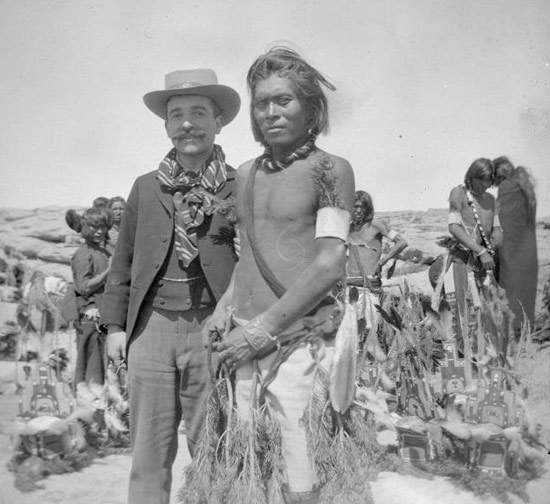 |
| Aby Warburg with a native Hopi |
Warburg stayed for some time in contact with the Hopi, studying their rituals, their forms of expression, their symbols. He was particularly fascinated by the so-called"snake ritual," an animal that was an object of special devotion by the Hopi. Warburg had noticed that among this population the snake was a symbol of lightning, and he wondered how this image, already attested in ancient works made by the Hopi, could manage to survive through time. Meanwhile, the scholar had considered the genesis of this symbol, and found that, for the Hopi, lightning had snake-like characteristics: it appears suddenly, it is fast, it is potentially dangerous, and it has a shape reminiscent of a reptile. The ancient Hopi had therefore associated the image of an unknown and uncontrollable force, that of lightning, with that of an animal well known to them, the snake, and this association of ideas contained an attempt to somehow master the power of lightning. For this reason, in some ritual dances of the Hopi, the snake is grasped with the mouth by the dancer: on a symbolic level, it is about controlling atmospheric events. And that it was such a powerful symbol that it crossed the ages was confirmed to Warburg by the drawings of some children of Hopi origin, but already integrated into American culture, whom the scholar had asked, through one of their teachers, to illustrate a story in which a thunderstorm was mentioned. Some of those children had depicted lightning in the same way their ancestors did, with a thunderbolt body and a triangular head like that of a snake. For Warburg it was a confirmation of the concept of Nachleben der Antike, “survival of the ancient,” and a demonstration of how very ancient patterns managed to survive even in the minds of almost completely Americanized children.
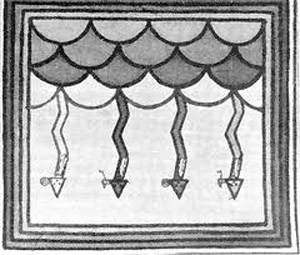 |
| The lightning bolt-snake drawn by one of the Hopi children. |
And the mechanism that had led the Hopi to identify the lightning bolt with the snake, that is, the one whereby one tries to associate a concept out of one’s control with one that one can dominate, was also being found by Warburg in our culture. One of the recurring characters in Renaissance art is the biblical heroine Judith grasping the head of her enemy Holofernes: Warburg had identified the classical precedent for this image in the maenads (or bacchae), the mythological women who celebrated the god Dionysus invaded, giving themselves over to the wildest actions. It is art historian Fritz Saxl who provides an interesting description of the connections between Western and Native American symbology: “symbolic forms are coined in the depths of human experience: the serpent is the symbol of lightning, the headhunter that of the invaded woman in her triumph over the male. These symbols have the power to limit and condense fear and dismay; and because they arise from the depths, and at the same time manage to articulate it, they survive in that strange medium that Warburg and others have called social memory. The serpent-lightning still lives in the minds of Americanized Indian children; the maenad appears in early Renaissance Florence as a Christianized figure, a formula for that intense emotion revived from classical antiquity.”
Toward the end of his career (this is 1927), Warburg developed the idea of bringing together in an organic work all the figurative repertoires he had studied during his activity, documenting their evolutions, returns, and permanences. A kind of"atlas of images"(Bilderatlas), to use Warburg’s own definition, he would title his project Mnemosyne, a name that alluded to the Greek deity of memory. The scholar had configured his atlas as a kind of photo album (a comparison we use just to make the point): it is divided into sections, which in turn consist of plates on which Warburg had placed photographic reproductions of works of art that went on to create real maps of figurative memory. A good example is Table 55 of Mnemosyne (which has been published in its entirety, replete with commentary and accompanied by numerous interpretive essays, on the online version of the journal Engramma), where the transmission of the figure of the nymph is traced, which (let us trivialize), starting from ancient sarcophagi and through the mediation of Raphael (in turn mediated by Marcantonio Raimondi), came all the way to a modern work such as Manet’s Le déjeuner sur l’herbe. The transition also takes place on a symbolic level: the gods, who lead their carefree lives on Olympus, fall to earth and become the characters who pleasantly frequent the French countryside.
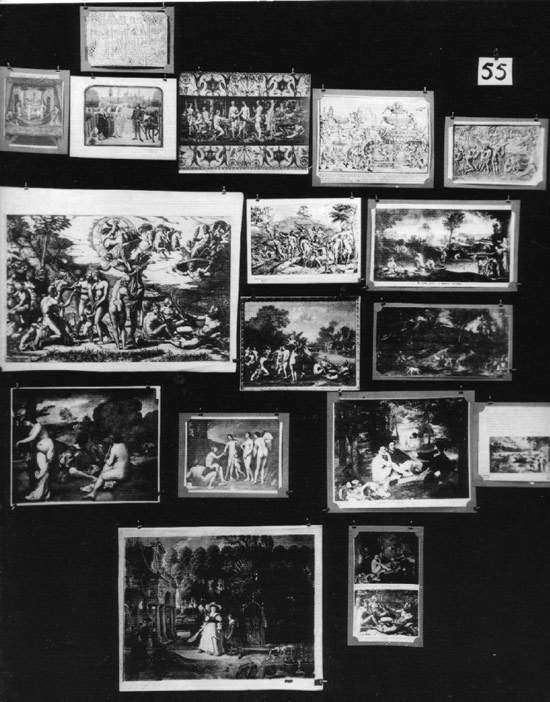 |
| Aby Warburg, Mnemosyne, Table 55 |
Aby Warburg’s ambitious work came to a halt when he passed away in 1929. Mnemosyne certainly remains the most innovative contribution offered to the subject by a scholar who was never particularly attracted to problems of attribution (he was not trained as a connoisseur, nor did it probably interest him), but who, on the contrary, was attracted to the processes that lead to the creation of images. And in defining the furrow of what was in fact a new discipline, Warburg played a key role.Iconology had been born: what, in reference to Warburg, Giorgio Agamben called “science without a name,” because we owe to Erwin Panofsky the first attempt to invent a term for this strand of art history of which Aby Warburg is considered one of the fathers.
Reference bibliography
- Claudia Cieri Via, Micol Forti, Aby Warburg and Italian culture: between survivals and perspectives, Mondadori, 2009
- Marco Bertozzi, La tirannia degli astri: gli affreschi astrologici di Palazzo Schifanoia, Sillabe, 2006
- Aby Warburg, Art and Astrology in the Schifanoia Palace of Ferrara, Abscondita, 2006 (Italian translation of Italienische Kunst und internationale Astrologie im Palazzo Schifanoja zu Ferrara from 1922)
- Ernst Gombrich, Aby Warburg. An Intellectual Biography, Feltrinelli, 2003 (first edition 1973)
- Marco Bertozzi, Aby Warburg and the metamorphoses of the ancient gods, Franco Cosimo Panini, 2002
- Roberto Cassanelli, Alessandro Conti, Michael Ann Holly and Adalgisa Lugli, Art. Criticism and Conservation, Jaca Book, 1996
- Aby Warburg, The Rebirth of Ancient Paganism, La Nuova Italia, 1966 (posthumous collection of essays translated into Italian)
- Fritz Saxl, Warburg’s visit to New Mexico, in Lectures, The Warburg Institute, 1957, pp.325-330
Warning: the translation into English of the original Italian article was created using automatic tools. We undertake to review all articles, but we do not guarantee the total absence of inaccuracies in the translation due to the program. You can find the original by clicking on the ITA button. If you find any mistake,please contact us.



























